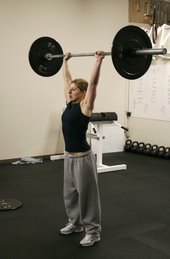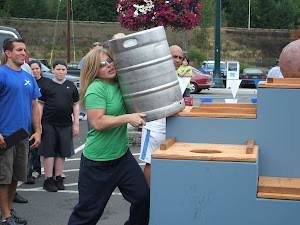I'm Sicilian and if I'm not talking with my hands I'm not talking. And, well, I'm talking a lot. I'm also tapping a foot, shifting from side to side, rocking in my chair and any combination of all of those things. It would be maddening and maybe even stigmatizing if it didn't turn out to be darn useful.
Fidgeting is not something I developed for it's healthful benefits. The truth is, I'm not sure why I do it though I wonder sometimes if it's genetic. An observer commented recently that whatever internal beat my sister and I were dancing to, it was at least nicely synchronized. We had no idea what he was talking about as we stood side by side silently swaying.
When the topic of fidgeting came up recently in a trainer meeting, I swear a few people glanced at me. It seems the Mayo Clinic did some research on Non-Exercise Activity Thermogenesis (NEAT) which is essentially an individuals energy expenditure (EE) during activity that does not constitute 'exercise'.
As the Mayo clinic explains, EE has three components:
Basal Metabolic Rate: "BMR is the energy expended when an individual is laying at complete rest, in the morning, after sleep, in the postabsorptive state. In individuals with sedentary occupations BMR accounts for approximately 60 percent of total daily EE. Three-quarter's of the variability in BMR is predicted by lean body mass within and across species." Though some argue that lean body mass alters caloric expenditure by only a handful of calories, I suspect that's not the whole story if you consider the process of building mass as well as the elevated caloric expenditure post-exercise. For an anaerobic workout (weight-lifting) energy expenditure stays elevated for 72 hours after the workout ends.
Thermic Effect of Food: "TEF is the increase in EE associated with the digestion, absorption, and storage of food and accounts for approximately 10-15 percent of total daily EE." The intake of nutrients is known to increase energy expenditure." Measured thermic effects of nutrient are 0-3% for fat, 5-10% for carbohydrates and 20-30% for proteins. And, by the way, you'll notice this is another argument for a higher protein diet.
Activity Thermogenesis: "Activity Thermogenesis has two constituents, exercise-related activity thermogenesis and Non-exercise Activity Thermogenesis (NEAT). For the vast majority of dwellers in the U.S., exercise activity thermogenesis is negligible. NEAT, even in avid exercisers, is the predominant constituent of activity thermogenesis and is the EE associated with all the activities we undertake as vibrant, independent beings. NEAT has an enormous variety of constituents including occupation, leisure and fidgeting."
Given the holidays and what was likely a change in patterns that included more food and less time in the gym, the following point is particularly relevant: "With experimental overfeeding in humans, NEAT increases. Those who increased their NEAT the most with overfeeding gained the least fat. This suggests that along with self-evident societal slothfulness, NEAT is biologically modulated. Animal data support this." What this means is that folks who bemoan a slow metabolism may be able to keep foods from 'sticking' quite so readily (click your heels, Dorothy . . . .)
According to the Mayo Clinic's research, "Even lean individuals store at least two to three months of their energy needs in adipose tissue whereas obese persons can carry a year's worth of their energy needs." Yes, they said a year. You may want to begin chipping away at that surplus by vigorously flapping your arms but I suspect that your friends won't find that either charmingly quirky or endearing. Instead, PRO endeavored to experiment using pedometers for the 20/20 clients with a requirement that they walk at least 5000 steps a day. Walking is categorized as NEAT and would represent some of the unintentional EE in question.
I too donned a pedometer and only in part because it was free. I was curious after reading several years ago that the average American walks 1000 steps a day while the average European walks approximately 10000 steps a day. And though I was trying to capture my average, bless my viciously competitive heart, I kept driving up the numbers.
I walked downtown from my Capitol Hill home several times to browse for Christmas gifts that I had no intention of buying. I made highly inefficient trips to the grocery store, walking the three blocks multiple times on a Sunday for individual items (though I've been known to call that QFC 'my other fridge', that was getting silly). I parked farther away from store entrances which I have often told clients to do but never intentionally done myself. And while shopping for the holiday brunch I cooked, I parked my cart in the middle of the store, retrieved each item one by one and returned to the cart to deposit them boosting my numbers significantly.
Given that I sometimes exercise multiple times a day, this would seem completely extraneous. When you ask yourself what does being healthy mean and what does it say about your lifestyle however, I would think part of the answer would be energy and vitality. It would also imply that your exercise fuels an active life rather than depletes you and keeps you circling parking lots in a holding pattern for 'rock star' parking. Having only two speeds, 'Stop' and 'Go', doesn't scream 'vibrant' to me.
skip to main |
skip to sidebar








A conversation with my clients about exercises, work-outs and nutrition
Search This Blog

About Me
- Heather
- I'm an NSCA-PT and CrossFit certified personal trainer with nine years experience. I hold a purple belt in Brazilian Jiu Jitsu under Marcelo Alonso and Ben Blackstone and I am a Karnataka State Gold Medalist in Weightlifting.

Books
Brain Rules: 12 Principles for Surviving and Thriving at Work, Home, and School Food Politics: How the Food Industry Influences Nutrition, and Health, Revised and Expanded Edition (California Studies in Food and Culture)
Food Politics: How the Food Industry Influences Nutrition, and Health, Revised and Expanded Edition (California Studies in Food and Culture) Good Calories, Bad Calories: Fats, Carbs, and the Controversial Science of Diet and Health (Vintage)
Good Calories, Bad Calories: Fats, Carbs, and the Controversial Science of Diet and Health (Vintage) The Omnivore's Dilemma: A Natural History of Four Meals
The Omnivore's Dilemma: A Natural History of Four Meals Practical Programming for Strength Training
Practical Programming for Strength Training PROTEIN POWER
PROTEIN POWER Secrets of the Soil : New Solutions for Restoring Our Planet
Secrets of the Soil : New Solutions for Restoring Our Planet Starting Strength (2nd edition)
Starting Strength (2nd edition) The Brain Trust Program: A Scientifically Based Three-Part Plan to Improve Memory, Elevate Mood, Enhance Attention, Alleviate Migraine and Menopausal Symptoms, and Boost Mental Energy
The Brain Trust Program: A Scientifically Based Three-Part Plan to Improve Memory, Elevate Mood, Enhance Attention, Alleviate Migraine and Menopausal Symptoms, and Boost Mental Energy Fiber Menace: The Truth About the Leading Role of Fiber in Diet Failure, Constipation, Hemorrhoids, Irritable Bowel Syndrome, Ulcerative Colitis, Crohn's Disease, and Colon Cancer
Fiber Menace: The Truth About the Leading Role of Fiber in Diet Failure, Constipation, Hemorrhoids, Irritable Bowel Syndrome, Ulcerative Colitis, Crohn's Disease, and Colon Cancer The Revolution Will Not Be Microwaved: Inside America's Underground Food Movements
The Revolution Will Not Be Microwaved: Inside America's Underground Food Movements The Zone: A Dietary Road Map to Lose Weight Permanently : Reset Your Genetic Code : Prevent Disease : Achieve Maximum Physical Performance
The Zone: A Dietary Road Map to Lose Weight Permanently : Reset Your Genetic Code : Prevent Disease : Achieve Maximum Physical Performance Twinkie, Deconstructed: My Journey to Discover How the Ingredients Found in Processed Foods Are Grown, Mined (Yes, Mined), and Manipulated into What America Eats
Twinkie, Deconstructed: My Journey to Discover How the Ingredients Found in Processed Foods Are Grown, Mined (Yes, Mined), and Manipulated into What America Eats Mind the Gap: The Science Behind the Sporting Mind
Mind the Gap: The Science Behind the Sporting Mind Extraordinary Knowing: Science, Skepticism, and the Inexplicable Powers of the Human Mind
Extraordinary Knowing: Science, Skepticism, and the Inexplicable Powers of the Human Mind The Subtle Body: An Encyclopedia of Your Energetic Anatomy
The Subtle Body: An Encyclopedia of Your Energetic Anatomy Stumbling on Happiness
Stumbling on Happiness
Products

Blog Archive
-
▼
2006
(16)
-
▼
December
(16)
- 'Is there a problem officer?'
- Blowing your mind but not your arteries . . .
- Be a kid again
- NEAT-O!
- Long Slow Recovery
- Not for the faint of heart
- Down time
- Protein Smack-down!
- Passion on deadline
- No resistance
- Sleeping it off
- What's your function?
- Farm Fueled
- Roped in
- A hamster for the holidays
- Get-up!
-
▼
December
(16)

Resources
- Art DeVany
- Brain Health
- Buy Kettlebells
- CrossFit Eastside
- CrossFit Main Page
- Dr. Cordain's Research
- Dr. Eades
- Dr. Ladd Carlston
- Dr. Randip Singh
- Environmental Working Group
- Food, Farming & Healing Arts
- Get Up! Newsletter
- Health Geek's Wikipedia
- Homework for 10a Class
- Jennifer Adler M.S., C.N.
- Marcelo Alonso BJJ
- Michael Pollan
- O'Lifting Coach Mike Burgener
- Predictably Irrational
- Robb Wolf
- TED: Ideas Worth Spreading
- THIS IS THE PREFERRED MEAL TRACKER
- Tim Ferriss, 4 Hour Work Week


